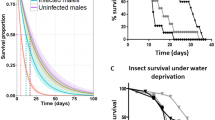Summary
A birth-death model developed for pathogens of vertebrates was used to estimate the in vivo rate of increase (α) and the doubling time (td) from survival time assay data. Host-pathogen combinations used in this study were twoAutographa californica nuclear polyhedrosis virus isolates inTrichoplusia ni andHeliothis zea NPV inH. zea. The α's, estimated as he negative reciprocal of the slope of the linearly decreasing section of the plot of median survival times against the logarithm of inoculum concentration, were calculated in two ways. First, simple regression was used to fit a line through the linearly decreasing part using data points selected by eye; secondly, a three-phase segmented linear regression model was used and α was estimated from the slope of the middle segment. Estimates of α (and td) were 0.338 (2.05), 0.274 (2.53) and 0.243 h−1 (2.85 h) using the simple regression method, and, 0.385 (1.80), 0.305 (2.27) and 0.223 h−1 (3.11 h) using the 3-phase segmented linear regression model for AcMNPV-1A, AcMNPV-HOB and HzSNPV, respectively. Although AcMNPV-HOB killed larvae faster (6 to 13 h) than AcMNPV-1A, it multiplied more slowly. Estimates for the critical number ranged from 4.8×109 to 4.5×1014 genome copies for HzSNPV inH. zea larvae and AcMNPV-1A inT. ni larvae, respectively. The significance of the calculated critical numbers is discussed.
Similar content being viewed by others
References
Allen DM, Cady FB (1982) Analyzing experimental data by regression. Wadsworth, Belmont
Armitage P, Meynell GG, Williams T (1965) Birth-death and other models for microbial infection. Nature 207: 570–572
Draper NR, Smith H (1981) Applied regression analysis, 2nd edn. Wiley, New York, pp 252–257
Granados RR, Lawler KA, Burand JP (1981) Replication ofHeliothis zea baculovirus in an insect cell line. Intervirology 16: 71–79
Gregory BG, Ignoffo CM, Shapiro M (1969) Nucleopolyhedrosis ofHeliothis: morphological description of inclusion bodies and virions. J Invertebr Pathol 14: 186–193
Huber J, Hughes PR (1984) Quantitative bioassay in insect pathology. Bull Entomol Soc Am 30: 31–34
Hughes PR, Gettig RR, McCarthy WJ (1983) Comparison of the time-mortality response ofHeliothis zea to 14 isolates ofHeliothis nuclear polyhedrosis virus. J Invertebr Pathol 41: 256–261
Hughes PR, van Beek NAM, Wood HA (1986) A modified droplet feeding method for rapid assay ofBacillus thuringiensis and baculoviruses in noctuid larvae. J Invertebr Pathol 48: 187–192
Hughes PR, Wood HA (1981) A synchronous peroral technique for the bioassay of insect viruses. J Invertebr Pathol 37: 154–159
Hughes PR, Wood HA (1986) In vivo and in vitro bioassay methods for baculoviruses. In: Granados RR, Federici BA (eds) The biology of baculoviruses, vol 2. CRC Press, Boca Raton, pp 1–30
Hughes PR, Wood HA, Burand JP, Granados RR (1984) Quantification of the dose-mortality response ofTrichoplusia ni, Heliothis zea, andSpodoptera frugiperda to nuclear polyhedrosis viruses: applicability of an exponential model. J Invertebr Pathol 43: 343–350
Meynell GG, Meynell EW (1958) The growth of micro-organisms in vivo with particular reference to the relation between dose and latent period. J Hyg (Camb) 56: 323–346
Saaty TL (1961) Some stochastic processes with absorbing barriers. J R Stat Soc [B] 23: 319–334
SAS Institute Inc (1985) SASR user's guide: statistics version, 5th edn. SAS Institute Inc., Cary, NC, pp 39–83
Shortley G (1965) A stochastic model for distributions of biological response times. Biometrics 21: 562–582
Shortley G, Wilkins JR (1965) Independent-action and birth-death models in experimental microbiology. Bacteriol Rev 29: 102–141
Van Beek NAM, Wood HA, Hughes PR (1988) Quantitative aspects of nuclear polyhedrosis virus infections in lepidopterous larvae: the dose-survival time relationship. J Invertebr Pathol 51: 58–63
Williams T (1965) The basic birth-death model for microbial infections. J R Stat Soc [B] 27: 338–360
Williams T (1965) The distribution of response times in a birth-death process. Biometrika 52: 581–585
Wood HA (1980) Protease degradation ofAutographa californica nuclear polyhedrosis virus proteins. Virology 103: 392–399
Wood HA, Hughes PR, Johnston LB, Langridge WHR (1981) Increased virulence ofAutographa californica nuclear polyhedrosis virus by mutagenesis. J Invertebr Pathol 38: 236–241
Author information
Authors and Affiliations
Rights and permissions
About this article
Cite this article
van Beek, N.A.M., Wood, H.A., Angellotti, J.E. et al. Rate of increase and critical amount of nuclear polyhedrosis virus in lepidopterous larvae estimated from survival time assay data with a birth-death model. Archives of Virology 100, 51–60 (1988). https://doi.org/10.1007/BF01310907
Received:
Accepted:
Issue Date:
DOI: https://doi.org/10.1007/BF01310907




